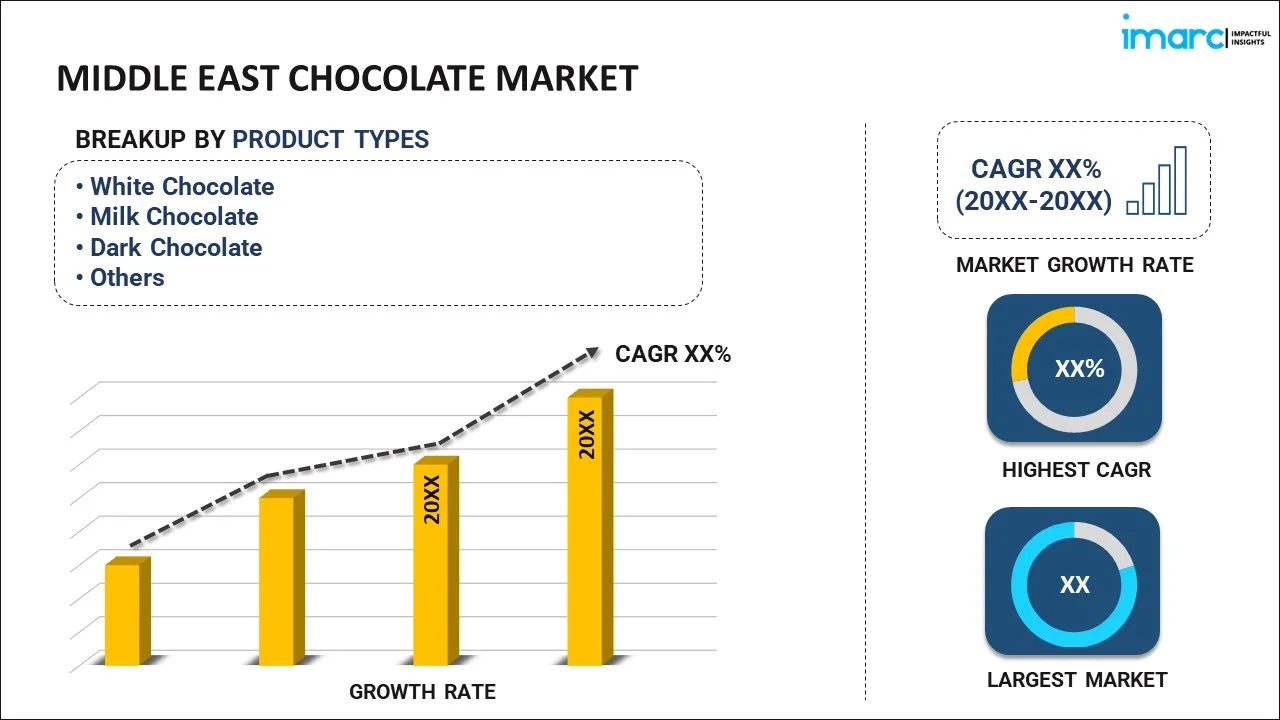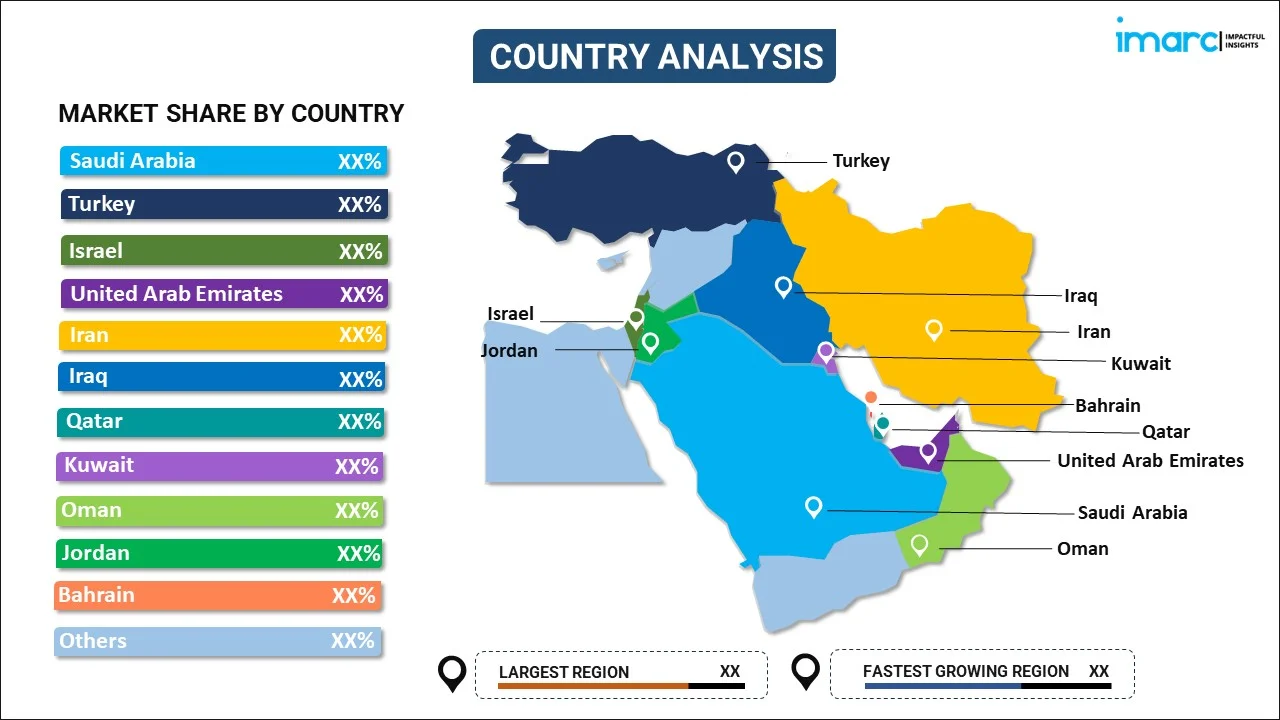
Middle East Chocolate Market Report by Product Type (White Chocolate, Milk Chocolate, Dark Chocolate, and Others), Product Form (Molded, Countlines, and Others), Application (Food Products, Beverages, and Others), Pricing (Everyday Chocolate, Premium Chocolate, Seasonal Chocolate), Distribution (Direct Sales (B2B), Supermarkets and Hypermarkets, Convenience Stores, Online Stores, and Others), and Country 2024-2032
Market Overview:
Middle East chocolate market size is projected to exhibit a growth rate (CAGR) of 4.05% during 2024-2032. The market is being driven by rising incomes, health-conscious consumers preferring dark chocolate, growing demand for ethically sourced products, expanded distribution networks, and innovative marketing strategies, with brands incorporating local flavors and sustainable practices.
|
Report Attribute
|
Key Statistics
|
|---|---|
|
Base Year
|
2023 |
|
Forecast Years
|
2024-2032
|
|
Historical Years
|
2018-2023
|
| Market Growth Rate (2024-2032) | 4.05% |
Chocolate is a confectionery product derived from the beans of the cacao tree. It is primarily composed of cocoa solids, butter, and sugar. Its preparation involves grinding cacao beans and adding sugar and milk, resulting in various types of chocolate, such as dark, milk, and white chocolate. It can be smooth and creamy when melted or solid and brittle when cooled. It has a sweet and rich flavor and distinct, pleasant aroma. It contains antioxidants, which help reduce oxidative stress and lower the risk of certain diseases. It aids in improving heart health by lowering blood pressure and enhancing circulation. It stimulates energy levels and provides pleasure and relaxation when consumed in moderation. It is widely used in various culinary applications, such as making desserts, cakes, cookies, and beverages like hot chocolate. It is also utilized in baking to add flavor and texture to cookies, brownies, and muffins.
Middle East Chocolate Market Trends:
The inflating income levels of individuals in the Middle East are allowing them to spend on premium and luxury chocolates. Additionally, the growing awareness among the masses about the importance of maintaining health and wellness is driving the demand for dark chocolates. Along with this, the growing environmental concerns among individuals are catalyzing the demand for ethically sourced and sustainable chocolate products. Brands are adopting recyclable and biodegradable packaging materials, reducing plastic usage, and implementing eco-friendly supply chain practices. Apart from this, the increasing exposure to international brands and flavors is offering a favorable market outlook. Along with this, the rising trend of gifting chocolates in the Middle East, especially during religious and cultural celebrations, is strengthening the growth of the market. Apart from this, the expansion of supermarkets, hypermarkets, convenience stores, and general stores is offering a wide distribution network for chocolate manufacturers, making their products more accessible. Furthermore, people are increasingly seeking premium and artisanal chocolate products, valuing quality and unique flavor experiences. Moreover, various chocolate brands are investing in innovative marketing strategies, including social media campaigns and partnerships with influencers, to create brand awareness and drive sales. They are also customizing their products to cater to Middle Eastern tastes, incorporating local flavors and packaging designs that resonate with the culture. Some brands are addressing health concerns by introducing chocolate products with reduced sugar content. Along with this, the introduction of innovative flavors inspired by Middle Eastern ingredients like saffron, rose, and cardamom is attracting a wider consumer base.
Middle East Chocolate Market Segmentation:
IMARC Group provides an analysis of the key trends in each segment of the market, along with forecasts at the regional and country levels for 2024-2032. Our report has categorized the market based on product type, product form, application, pricing, and distribution.
Product Type Insights:

- White Chocolate
- Milk Chocolate
- Dark Chocolate
- Others
The report has provided a detailed breakup and analysis of the market based on the product type. This includes white chocolate, milk chocolate, dark chocolate, and others.
Product Form Insights:
- Molded
- Countlines
- Others
A detailed breakup and analysis of the market based on the product form have also been provided in the report. This includes molded, countlines, and others.
Application Insights:
- Food Products
- Bakery Products
- Sugar Confectionary
- Desserts
- Others
- Beverages
- Others
The report has provided a detailed breakup and analysis of the market based on the application. This includes food products (bakery products, sugar confectionary, desserts, and others), beverages, and others.
Pricing Insights:
- Everyday Chocolate
- Premium Chocolate
- Seasonal Chocolate
A detailed breakup and analysis of the market based on the pricing have also been provided in the report. This includes everyday chocolate, premium chocolate, and seasonal chocolate.
Distribution Insights:
- Direct Sales (B2B)
- Supermarkets and Hypermarkets
- Convenience Stores
- Online Stores
- Others
The report has provided a detailed breakup and analysis of the market based on the distribution. This includes direct sales (B2B), supermarkets and hypermarkets, convenience stores, online stores, and others.
Country Insights:

- Saudi Arabia
- Turkey
- Israel
- United Arab Emirates
- Iran
- Iraq
- Qatar
- Kuwait
- Oman
- Jordan
- Bahrain
- Others
The report has also provided a comprehensive analysis of all the major regional markets, which include Saudi Arabia, Turkey, Israel, United Arab Emirates, Iran, Iraq, Qatar, Kuwait, Oman, Jordan, Bahrain, and Others.
Competitive Landscape:
The market research report has also provided a comprehensive analysis of the competitive landscape in the market. Competitive analysis such as market structure, key player positioning, top winning strategies, competitive dashboard, and company evaluation quadrant has been covered in the report. Also, detailed profiles of all major companies have been provided. Some of the key players include:
- Barry Callebaut AG
- Ferrero SpA
- Forrey and Galland
- Godiva Chocolatier
- Patchi
(Please note that this is only a partial list of the key players, and the complete list is provided in the report.)
Middle East Chocolate Market Report Coverage:
| Report Features | Details |
|---|---|
| Base Year of the Analysis | 2023 |
| Historical Period | 2018-2023 |
| Forecast Period | 2024-2032 |
| Units | US$ Million |
| Scope of the Report | Exploration of Historical and Forecast Trends, Industry Catalysts and Challenges, Segment-Wise Historical and Predictive Market Assessment:
|
| Product Types Covered | White Chocolate, Milk Chocolate, Dark Chocolate, Others |
| Product Forms Covered | Molded, Countlines, Others |
| Applications Covered |
|
| Pricings Covered | Everyday Chocolate, Premium Chocolate, Seasonal Chocolate |
| Distributions Covered | Direct Sales (B2B), Supermarkets and Hypermarkets, Convenience Stores, Online Stores, Others |
| Countries Covered | Saudi Arabia, Turkey, Israel, United Arab Emirates, Iran, Iraq, Qatar, Kuwait, Oman, Jordan, Bahrain, Others |
| Companies Covered | Barry Callebaut AG, Ferrero SpA, Forrey and Galland, Godiva Chocolatier, Patchi, etc. (Please note that this is only a partial list of the key players, and the complete list is provided in the report.) |
| Customization Scope | 10% Free Customization |
| Report Price and Purchase Option | Single User License: US$ 3699 Five User License: US$ 4699 Corporate License: US$ 5699 |
| Post-Sale Analyst Support | 10-12 Weeks |
| Delivery Format | PDF and Excel through Email (We can also provide the editable version of the report in PPT/Word format on special request) |
Key Questions Answered in This Report:
- How has the Middle East chocolate market performed so far and how will it perform in the coming years?
- What has been the impact of COVID-19 on the Middle East chocolate market?
- What is the breakup of the Middle East chocolate market on the basis of product type?
- What is the breakup of the Middle East chocolate market on the basis of product form?
- What is the breakup of the Middle East chocolate market on the basis of application?
- What is the breakup of the Middle East chocolate market on the basis of pricing?
- What is the breakup of the Middle East chocolate market on the basis of distribution?
- What are the various stages in the value chain of the Middle East chocolate market?
- What are the key driving factors and challenges in the Middle East chocolate?
- What is the structure of the Middle East chocolate market and who are the key players?
- What is the degree of competition in the Middle East chocolate market?
Key Benefits for Stakeholders:
- IMARC’s industry report offers a comprehensive quantitative analysis of various market segments, historical and current market trends, market forecasts, and dynamics of the Middle East chocolate market from 2018-2032.
- The research report provides the latest information on the market drivers, challenges, and opportunities in the Middle East chocolate market.
- Porter's five forces analysis assist stakeholders in assessing the impact of new entrants, competitive rivalry, supplier power, buyer power, and the threat of substitution. It helps stakeholders to analyze the level of competition within the Middle East chocolate industry and its attractiveness.
- Competitive landscape allows stakeholders to understand their competitive environment and provides an insight into the current positions of key players in the market.
Need more help?
- Speak to our experienced analysts for insights on the current market scenarios.
- Include additional segments and countries to customize the report as per your requirement.
- Gain an unparalleled competitive advantage in your domain by understanding how to utilize the report and positively impacting your operations and revenue.
- For further assistance, please connect with our analysts.
 Inquire Before Buying
Inquire Before Buying
 Speak to an Analyst
Speak to an Analyst
 Request Brochure
Request Brochure
 Request Customization
Request Customization




.webp)




.webp)












